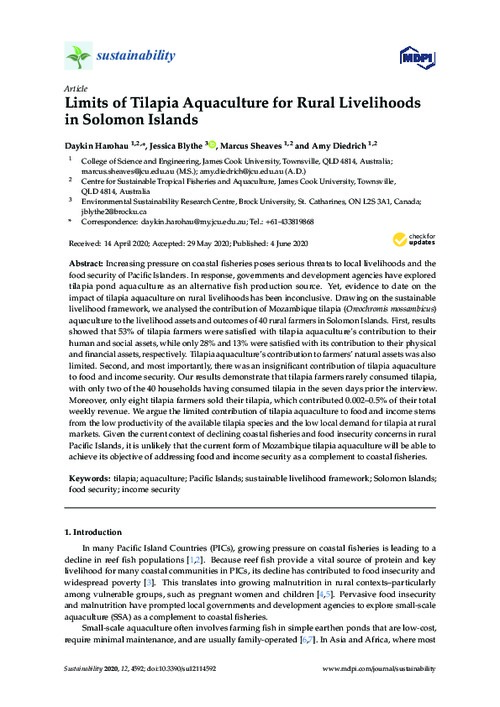Please use this identifier to cite or link to this item:
https://hdl.handle.net/20.500.12348/4244
Limits of tilapia aquaculture for rural livelihoods in Solomon Islands
| dc.creator | Harohau, D.O. | en_US |
| dc.creator | Blythe, J. | en_US |
| dc.creator | Sheaves, M. | en_US |
| dc.creator | Dierich, A. | en_US |
| dc.date.accessioned | 2020-07-24T09:37:19Z | |
| dc.date.available | 2020-07-24T09:37:19Z | |
| dc.date.issued | 2020 | en_US |
| dc.identifier.citation | Harohau, D. Blythe, J. Sheaves, M. Diedrich, A. (2020). Limits of Tilapia Aquaculture for Rural Livelihoods in Solomon Islands. Sustainability, 12(11): 4592. | en_US |
| dc.identifier.issn | 2071-1050 | en_US |
| dc.identifier.uri | https://hdl.handle.net/20.500.12348/4244 | |
| dc.description.abstract | Increasing pressure on coastal fisheries poses serious threats to local livelihoods and the food security of Pacific Islanders. In response, governments and development agencies have explored tilapia pond aquaculture as an alternative fish production source. Yet, evidence to date on the impact of tilapia aquaculture on rural livelihoods has been inconclusive. Drawing on the sustainable livelihood framework, we analysed the contribution of Mozambique tilapia (Oreochromis mossambicus) aquaculture to the livelihood assets and outcomes of 40 rural farmers in Solomon Islands. First, results showed that 53% of tilapia farmers were satisfied with tilapia aquaculture’s contribution to their human and social assets, while only 28% and 13% were satisfied with its contribution to their physical and financial assets, respectively. Tilapia aquaculture’s contribution to farmers’ natural assets was also limited. Second, and most importantly, there was an insignificant contribution of tilapia aquaculture to food and income security. Our results demonstrate that tilapia farmers rarely consumed tilapia, with only two of the 40 households having consumed tilapia in the seven days prior the interview. Moreover, only eight tilapia farmers sold their tilapia, which contributed 0.002–0.5% of their total weekly revenue. We argue the limited contribution of tilapia aquaculture to food and income stems from the low productivity of the available tilapia species and the low local demand for tilapia at rural markets. Given the current context of declining coastal fisheries and food insecurity concerns in rural Pacific Islands, it is unlikely that the current form of Mozambique tilapia aquaculture will be able to achieve its objective of addressing food and income security as a complement to coastal fisheries. | en_US |
| dc.format | en_US | |
| dc.language | en | en_US |
| dc.publisher | MDPI | en_US |
| dc.rights | CC-BY-4.0 | en_US |
| dc.source | Sustainability;12,(2020) | en_US |
| dc.subject | income security | en_US |
| dc.subject | sustainable livelihood framework | en_US |
| dc.title | Limits of tilapia aquaculture for rural livelihoods in Solomon Islands | en_US |
| dc.type | Journal Article | en_US |
| cg.contributor.crp | Fish | en_US |
| cg.contributor.funder | CGIAR System Organization | en_US |
| cg.coverage.country | Solomon Islands | en_US |
| cg.coverage.region | Melanesia | en_US |
| cg.subject.agrovoc | aquaculture | en_US |
| cg.subject.agrovoc | food security | en_US |
| cg.subject.agrovoc | pacific islands | en_US |
| cg.subject.agrovoc | tilapia | en_US |
| cg.subject.agrovoc | solomon islands | en_US |
| cg.contributor.affiliation | James Cook University | en_US |
| cg.contributor.affiliation | Brock University | en_US |
| cg.contributor.affiliation | James Cook University, College of Science and Engineering | en_US |
| cg.identifier.status | Open access | en_US |
| cg.identifier.ISIindexed | ISI indexed | en_US |
| cg.description.theme | Resilient small-scale fisheries | en_US |
| cg.description.theme | Sustainable aquaculture | en_US |
Files in this item
This item appears in the following Collection(s)
-
Resilient small-scale fisheries [1337]
-
Sustainable aquaculture [2735]
